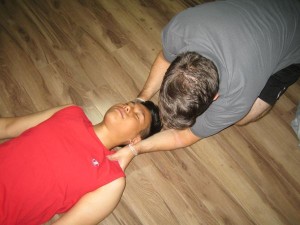Overview

A fracture occurs whenever a bone either cracks or breaks. In fact, jaw fractures are considered to be the third most common of all facial fractures alongside cheekbones and noses. There are all sorts of issues that can cause this, including the following:
- Accidental falls
- Hitting the dashboard after an auto accident
- Falling from a bike or motorcycle
- A collision or fall while playing contact sports
- Getting punched in the jaw
The jaw bone is also commonly referred to as the mandible. In essence, this is a long bone that includes your chin and also angles up to your ear on both sides of your face. The end of the jawbone on each side is rounded, almost like a ball. Known as the condyle, this portion of the jaw bone is located right in front of your ear and allows you to open and close your mouth. This particular joint is also sometimes referred to as the temporomandibular joint, or TMJ.
Symptoms
Some of the most common symptoms of a broken jaw include the following:
- Swelling, tenderness, and/or bruising below your ear or along your jaw
- Feeling that your teeth don’t properly fit together or that your overall bite isn’t perfect
- Your teeth aren’t properly aligned
- You have teeth that are either missing or loose
- There is bruising or swelling in the area over your jawbone
- You’re having difficulty opening your mouth
- You’re feeling pain in your jaw joint
- Numbness in either your chin or lower lip, which can be a sign of possible nerve damage
When Should You Call a Doctor?
Your dentist or doctor should be contacted immediately if you have the following symptoms after suffering some sort of a blow to your jaw:
- Your jaw has become either crooked or deformed, or it has suddenly shifted from its normal position
- There is a painful lump either below your ear or in your jaw
- Feeling that your teeth don’t properly fit together or that your overall bite isn’t perfect
- You have teeth that are either missing or loose
- There is bruising or swelling in the area over your jawbone
- You have difficulty opening your mouth or are experiencing pain in your jaw joint
- Numbness in either your chin or lower lip
Prevention
There are a few different ways that you can prevent yourself from getting any trauma to either your chin or the lower part of your face. This includes the following:
- Whenever you ride in a car, always wear your seatbelt, even is the car already has airbags. A seatbelt will help protect all of your facial bones and your upper body from impacting the dashboard, as well as other facial injuries.
- Wear headgear and mouth guards while playing contact sports. Mouth guards protect your teeth from impacts, and they can also offer extra protection against jaw fractures.
- Don’t allow children to take part in amateur boxing, as this particular sport is opposed by the American Academy of Pediatrics.
More Information
The details posted on this page for Broken Jaws and head, neck and spinal injuries is for information / learning purposes only. To learn to manage these injuries and help others register for a first aid and CPR course with one of our training providers today.
